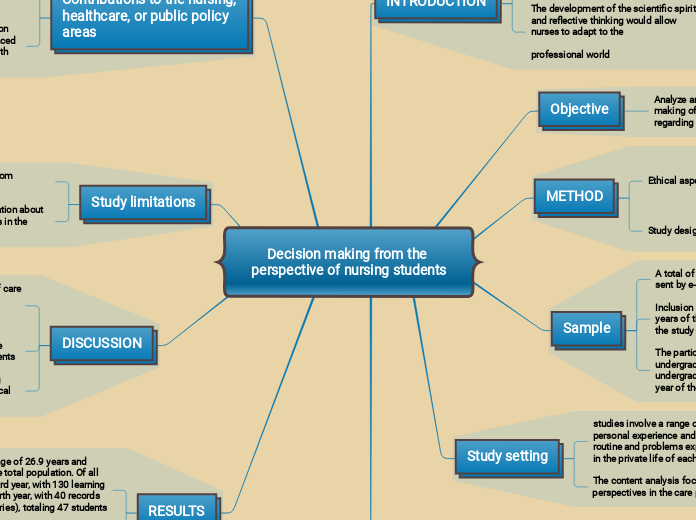Decision making from the perspective of nursing students
INTRODUCTION
The recognition of the nurse as a decision-making element was
certified by the Portuguese Nurses Association
The development of the scientific spirit
and reflective thinking would allow nurses to adapt to the
professional world
Objective
Analyze and understand the decision-making of some high school students regarding the nursing care process
METHOD
Ethical aspects
Study approved by the presidency of the Lisbon Nursing School, with the prior authorization of the students who decided to participate and the signature of consent was not required.
Study design
This was a qualitative study, with an exploratory and descriptive analysis
Sample
A total of 614 students were recruited through a request
sent by e-mail. Of these, 47 students replied.
Inclusion criteria were: students attending clinical training of the third and fourth years of the nursing undergraduate course and agreeing to voluntarily participate in the study
The participants were identified as 3S (students attending the third year of the undergraduate nursing course) and 4S (students attending the fourth year of the undergraduate nursing course), plus a number according to the order of invitation and year of the undergraduate course
Study setting
studies involve a range of empirical material, such as personal experience and introspection, describing daily routine and problems experienced, as well as their meanings in the private life of each participant
The content analysis focused on the students’ perspectives in the care process, rather than care itself
Data analysis
Students' learning journals and field notes were categorized
The internal researcher inductively through reflection, on the data to develop the learning description of the decision making of the students in the care process
Contributions to the nursing, healthcare, or public policy areas
if schools’ curricula provide the necessary means to facilitate decision-making development and if students are encouraged to participate in every decision-making type.
Knowing the response forms of students’ decision making in the face of clinical situations experienced enables the promotion of a pedagogical work with worthwhile learning.
Study limitations
1 : Lack of oral information from students
2: Lack of participant observation about how students made decisions in the clinical context
DISCUSSION
Teaching how to decide must meet the increasing complexity of care
contexts and promote students’ ability to reason about changes
in clinical situations, considering the context and centrality of
patients and families in the care process.
At the professional level, nurses are increasingly required to have decision-making skills to provide safe and effective care to patients
Nursing students have expectations of showing decisionmaking skills during their educational process, more specifically in clinical practice
RESULTS
The 614 students presented a mean age of 26.9 years and
459 were women, that is, 74.8% of the total population. Of all
participants, 37 were attending the third year, with 130 learning
diaries, and 10 were attending the fourth year, with 40 records
(including field notes and learning diaries), totaling 47 students
and 170 records
The study of the decision-making typology that the students
described in their records was based on the categorization of
Thompson and Stapley
The authors categorize six decision-making types: intervention; targeting; timing; communication; management; and understanding, which were used in an analysis of the learning diaries and field notes.
